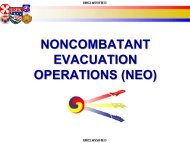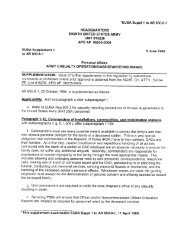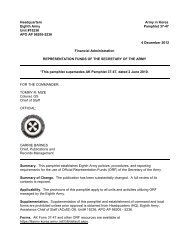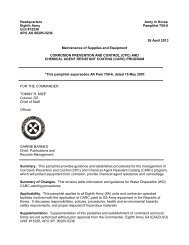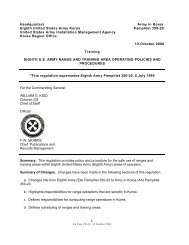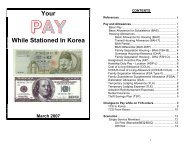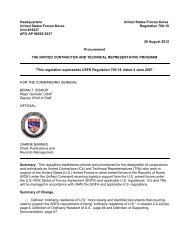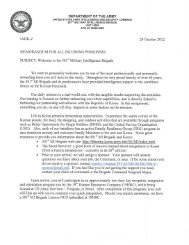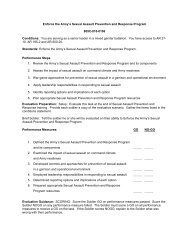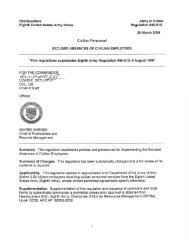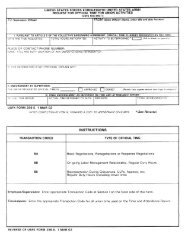CAS3 Staff Officer Guide - U.S. Army
CAS3 Staff Officer Guide - U.S. Army
CAS3 Staff Officer Guide - U.S. Army
Create successful ePaper yourself
Turn your PDF publications into a flip-book with our unique Google optimized e-Paper software.
© 2005 <strong>CAS3</strong> For Instructional Purposes Only<br />
Compiled by www.<strong>Army</strong>Toolbag.com<br />
Correspondence 74<br />
d. Decision makers may make pen and ink changes for minor errors only on internal documents.<br />
<strong>Staff</strong> officers should never assume that a pen and ink change is acceptable when presenting a<br />
document for signature.<br />
Citing References<br />
a. References help the addressee of the correspondence in obtaining additional information.<br />
References also help the writer achieve brevity by referring the addressee to other documents for the<br />
minute details. If you use a reference:<br />
(1) Include the reference paragraph as the document’s first paragraph.<br />
(2) Include the date of referenced publications.<br />
(3) Italicize or underline the titles of referenced publications.<br />
(4) Enclose the reference if the addressee cannot readily obtain the document.<br />
b. Examples of references:<br />
(1) For a publication: AR 25-50, Preparing and Managing Correspondence, 5 Mar 01.<br />
(2) For a memorandum: Memorandum, HQ 52d ID (M) & Fort Riley, ABCA-CS, 10 Jun xx,<br />
subject: Promotion Lists.<br />
(3) For a telephone conversation: Reference telephone conversation between COL Green,<br />
this office, and COL White, III Corps, 10 Jun xx, subject: Promotion Lists.<br />
Use of Office Symbols<br />
The office symbol at the top or bottom of correspondence and other documents will identify the<br />
specific office that prepared, filed the record copy, and has the most detailed knowledge about the<br />
subject. Refer to 52d ID (M) & FR Memo 340-9 for authorized office symbols.<br />
Use of Acronyms and Abbreviations<br />
a. Memorandums. Use abbreviations authorized in AR 310-50. Use standard dictionaries for<br />
abbreviations not contained in AR 310-50. Abbreviated ranks are authorized for memorandums and<br />
personal correspondence. General officers will use their full rank on all formal or official<br />
correspondence.<br />
b. Letters. Use only common abbreviations found in standard dictionaries. Do not use military<br />
abbreviations, acronyms, or military jargon in letters addressed to persons outside the DOD. Military<br />
personnel will use their full rank (for example, Lieutenant, Captain, Sergeant) for letters.<br />
c. Abbreviation guidelines.<br />
(1) Established and well-known abbreviations are acceptable in all but the most formal<br />
writing.<br />
(2) When a word or title that is not well known will be used more than once in a document,<br />
place the abbreviated form in parentheses after the first time the word or title is used. Thereafter,



